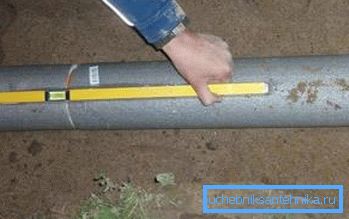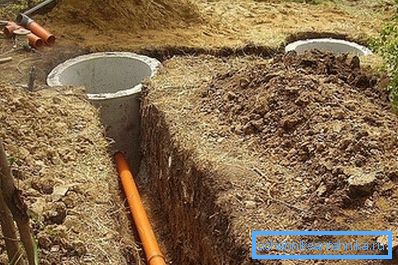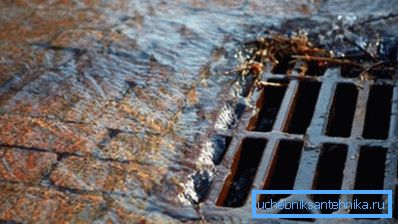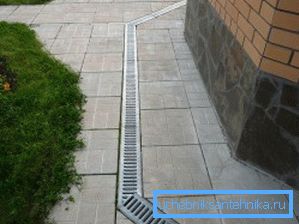What should be the slope of the sewer
To ensure normal disposal of sewage, the slope of the sewage system at 1 meter according to SNiP 2.04.01-85 * should be 2 cm, but these standards apply to a gasket with a diameter of 100 mm. In addition, to optimize the removal of all solid waste and to maximize the occurrence of blockages, a certain order should be followed for turns and transitions from the riser to the vertical plane.
This will be discussed below, that is, we will look at the rules for laying external and internal sewage systems in a private house and / or apartment, and also show you the video in this article.

Sewer pipe laying

The nuances of the internal layout
Note. In the apartment and in a private house, the instruction recommends the use of plastic pipes with a diameter of 50 mm and 100 mm for internal wiring. A larger section is used only for the toilet, while 50 mm pipes are needed for all other sanitary facilities. In addition, a diameter of 32 mm is used for washing machines and dishwashers.

- In the apartment of a multistory building, the waste sewer system takes up minimal space, however, the slope of the internal sewage system must comply with sanitary norms and rules., indicated in the SNiP 2.04.01-85 * and you see such numbers on the schematic image with the signature Optimal bias.
- In apartments, the toilet is usually connected directly to the tee., which is located on the riser, but sometimes (especially on the first floors) there is a need to install a check valve. In such cases, you will have to divert the 100-mm pipe horizontally for valve insertion, so you should not forget about the 20-mm slope, although the locking device is set to a level in a strictly horizontal position.
- For 50-mm pipes, the slope is 3 cm per linear meter, but in short sections it can be increased, since in this case solid waste is not meant. The only sewage system in the apartment without a slope is a 32-millimeter sewer for a washing and / or washing machine — there is forced water coming off, therefore, the degree of the plane is not decisive.
- In a private house, sewer routes can be more than 4 meters, so they should be provided with revisions to eliminate possible blockages.. In addition, should be avoided turns 90? - for this purpose it is best to use two corner fittings of 45? each. Rotate 90? It is optimal only for risers when they move into a horizontal plane. Also swivel fittings for 90? relevant in the apartment for 50-mm and 32-mm pipes - there are short distances and therefore the possibility of blockage is minimal.
External wiring

Now let's move to the layout in the yard, where the maximum slope of the external sewage system is exactly the same as in the room and directly depends on the diameter of the pipes. For private use, as a rule, a cross section of 100 mm and 150 mm is applied, which means that the optimal slope will be 2.0 cm and 0.8 cm, and the maximum - 2.5 cm and 1.3 cm, respectively. It should be remembered that the price of the material here has absolutely no value.
Note. The quality of communications installation depends on the question of what slope a sewage system should have. The fact is that if the slope is less than the norm, then the weak pressure of the water that flows by gravity will not be able to wash away solid waste (feces), and if the rate is too high, then the water just will not have time to do it. It turns out that in both cases a cake will form on the inner walls of the pipe, and blockages on the turns.
As for the turns, there are also used fittings for 32? and 45 ?, but to turn 90? use two angular connections of 45 ?. Just as in the room, the fitting is 90? relevant only for the riser when moving to a horizontal plane.

The depth of the trench in this case will depend on two factors - it is the maximum point of soil freezing in the region and the distance from the house to the septic tank (cesspool).
For example, if the freezing point is at a depth of 70 cm, then at the exit from the building for a 100 mm pipe the trench will have 90 cm (10 cm per diameter and 10 cm at a distance from the critical level). But sewage without a slope can not be, therefore, if the distance to the septic tank is 20 m, then the septic tank, this depth will be 70 + 20 * 2 = 110 cm.
In addition, there should be a sand cushion at the bottom of the trench - this allows laying at a certain level and evenly distributing the pipe area on the ground. Consequently, the rough depth of the trench (without sand cushion) should be at least 5-10 cm more.

When arranging a suburban area, the slope of the storm sewage system according to SNiP also depends on the diameter of the pipes and complies with the norms and rules specified above in the text. Also here it is necessary to observe the depth of the gasket, and since rainfall is usually associated with home sanitary facilities, it is mandatory to install a non-return sewer check valve.

If the storm is made in the form of a gutter, then the slope must be at least 5-10 mm per linear meter, but this is if there is a protective grid above, as in the photo above. If there is no protection, and debris (leaves) can get into the chute, then the slope should be increased to 2 cm.
Conclusion
Observing the maximum and minimum slope of the sewage during its installation, you can achieve a good outflow of water from the bathrooms, which also prevents the occurrence of unpleasant odors. Also, do not lower the diameter of the pipe along the runoff - this will lead to blockages.